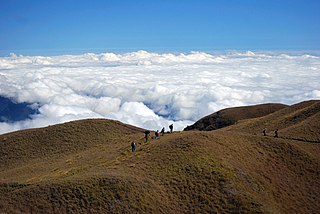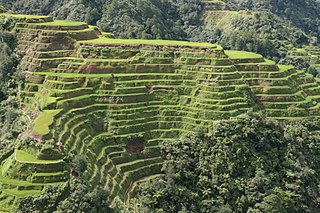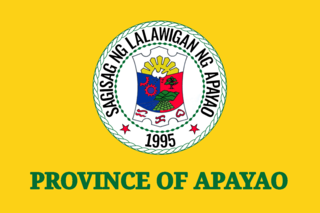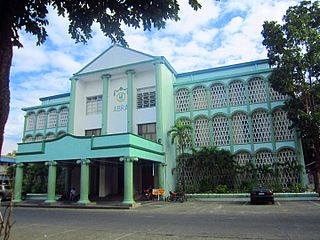Related Research Articles

Benguet, officially the Province of Benguet, is a landlocked province of the Philippines located in the southern tip of the Cordillera Administrative Region in the island of Luzon. Its capital is La Trinidad.

Ifugao is a landlocked province of the Philippines in the Cordillera Administrative Region in Luzon. Its capital is Lagawe and it borders Benguet to the west, Mountain Province to the north, Isabela to the east, and Nueva Vizcaya to the south.

Mountain Province is a landlocked province of the Philippines in the Cordillera Administrative Region in Luzon. Its capital is Bontoc. Mountain Province was formerly referred to as Mountain in some foreign references. The name is usually shortened by locals to Mt. Province.

Apayao is a landlocked province in the Philippines in the Cordillera Administrative Region in Luzon. Kabugao serves as its capital. The provincial capitol and its associated offices are located at the New Government Center in Luna.

Kalinga is a landlocked province in the Philippines situated within the Cordillera Administrative Region in Luzon. Its capital is Tabuk and borders Mountain Province to the south, Abra to the west, Isabela to the east, Cagayan to the northeast, and Apayao to the north. Kalinga and Apayao are the result of the 1995 partitioning of the former province of Kalinga-Apayao which was seen to better service the respective needs of the various indigenous peoples in the area.

Kalinga-Apayao was a province of the Philippines in the Cordillera Administrative Region in the island of Luzon. It was formed, along with Benguet, Ifugao, and the new Mountain Province, from the earlier Mountain Province, with the passage of Republic Act No. 4695 in 1966. The said law was amended by RA No. 7878 in 1995, which divided the province into two new ones, Kalinga and Apayao.

The Cordillera Administrative Region, also known as the Cordillera Region, or simply, Cordillera, is an administrative region in the Philippines, situated within the island of Luzon. It is the only landlocked region in the insular country, bordered by the Ilocos Region to the west and southwest, and by the Cagayan Valley Region to the north, east, and southeast. It is the least populous region in the Philippines, with a population less than that of the city of Manila.

The Cordillera Central or Cordillera Range is a massive mountain range 320 km long north-south and 118 km east-west. The Cordillera mountain range is situated in the north-central part of the island of Luzon, in the Philippines. The mountain range encompasses all provinces of the Cordillera Administrative Region, as well as portions of eastern Ilocos Norte, eastern Ilocos Sur, eastern La Union, northeastern Pangasinan, western Nueva Vizcaya, and western Cagayan.

The indigenous peoples of the Cordillera Mountain Range of northern Luzon, Philippines are often referred to using the exonym Igorot people, or more recently, as the Cordilleran peoples. There are nine main ethnolinguistic groups whose domains are in the Cordillera Mountain Range, altogether numbering about 1.5 million people in the early 21st century.

Abra, officially the Province of Abra, is a 3rd class province in the Cordillera Administrative Region of the Philippines. Its capital is the municipality of Bangued. It is bordered by Ilocos Norte on the northwest, Apayao on the northeast, Kalinga on the mid-east, Mountain Province on the southeast, and Ilocos Sur on the southwest.

The Rice Terraces of the Philippine Cordilleras are a World Heritage Site consisting of a complex of rice terraces on the island of Luzon in the Philippines. They were inscribed on the UNESCO World Heritage List in 1995, the first-ever property to be included in the cultural landscape category of the World Heritage List. This inscription has five sites: the Batad Rice Terraces and Bangaan Rice Terraces, Mayoyao Rice Terraces, Hungduan Rice Terraces and Nagacadan Rice Terraces, all in Ifugao Province, Philippines. The Ifugao Rice Terraces reach a higher altitude and were built on steeper slopes than many other terraces. The Ifugao complex of stone or mud walls and the careful carving of the natural contours of hills and mountains to make terraced pond fields, coupled with the development of intricate irrigation systems, harvesting water from the forests of the mountain tops, and an elaborate farming system.
The legislative districts of Mountain Province are the representations of Mountain Province in the various national legislatures of the Philippines. The province is currently represented in the lower house of the Congress of the Philippines through its lone congressional district.

The 1998 Cordillera Autonomy plebiscite was held on March 7, 1998. In the plebiscite, the people of Cordillera were asked if they wanted to be autonomous region under Republic Act No. 8438. The Cordillera Administrative Region (CAR) consists of the provinces of Abra, Benguet, Ifugao, Kalinga, Mountain Province and Apayao.
Philippine Science High School Cordillera Administrative Region Campus (PSHS-CARC) is one of the two campuses of the Philippine Science High School System established in 2009. The other one is Philippine Science High School Central Luzon Campus located in Clark, Pampanga. The PSHS-CARC was established through the congressional efforts of Baguio City Representative Mauricio G. Domogan.

The pasiking is the indigenous basket-backpack found among the various ethno-linguistic groups of Northern Luzon in the Philippines. Pasiking designs have sacred allusions, although most are purely aesthetic. These artifacts, whether handwoven traditionally or with contemporary variations, are considered exemplars of functional basketry in the Philippines and among Filipinos.
The Cordillera People's Liberation Army (CPLA) was a militant organization based in the Cordillera region in the Philippines founded by Conrado Balweg.
Conrado Balweg was a former Filipino Catholic priest and rebel who was the founder of the Cordillera People’s Liberation Army, a militant group which advocated autonomy for the Cordillera region in the Philippines. He was also known by the nom-de-guerreKa Ambo.

The Cordillera autonomy movement in the Philippines refers to the campaign for greater autonomy for the Cordilleras.

The COVID-19 pandemic in the Cordillera Administrative Region is part of the worldwide pandemic of coronavirus disease 2019 caused by severe acute respiratory syndrome coronavirus 2. The virus reached the Cordillera Administrative Region on March 20, 2020, when the first case of the disease was confirmed to involve a resident of Manabo, Abra. All provinces, as well as the independent city of Baguio has recorded at least one confirmed COVID-19 case.

A plebiscite for the ratification of the organic act creating the Cordillera Autonomous Region was held on January 30, 1990, to ask if the voters in the Cordillera Administrative Region wanted to be an autonomous region under Republic Act No. 6766. The Cordillera Administrative Region (CAR) consists of the provinces of Abra, Benguet, Ifugao, Kalinga-Apayao, and Mountain Province, and the city of Baguio. Only Ifugao voted in favor of autonomy, and a Supreme Court case later disallowed the creation of an autonomous region with just one province.
References
- ↑ "Rehabilitation of Mount Data Hotel Pressed". Herald Express. April 23, 2018. Archived from the original on October 11, 2020. Retrieved October 4, 2020.
- 1 2 3 4 "Historical Background of Cordillera's Pursuit for Regional Development and Autonomy". Regional Development Council. Archived from the original on July 17, 2013. Retrieved September 4, 2013.
- ↑ Dumlao, Artemio (January 31, 2013). "Rebels Still Dream of Cordillera's Autonomy". Philstar Global. Archived from the original on October 3, 2017. Retrieved October 3, 2017.
- ↑ "Former Cordillera Rebel Factions Reunited". Regional Development Council. Archived from the original on July 17, 2013. Retrieved September 4, 2013.
- ↑ De Mesa, Karl (September 20, 2011). "Cordillera Celebrates 25th Anniversary of Peace Accord". GMA News Online. Archived from the original on October 8, 2020. Retrieved October 5, 2020.